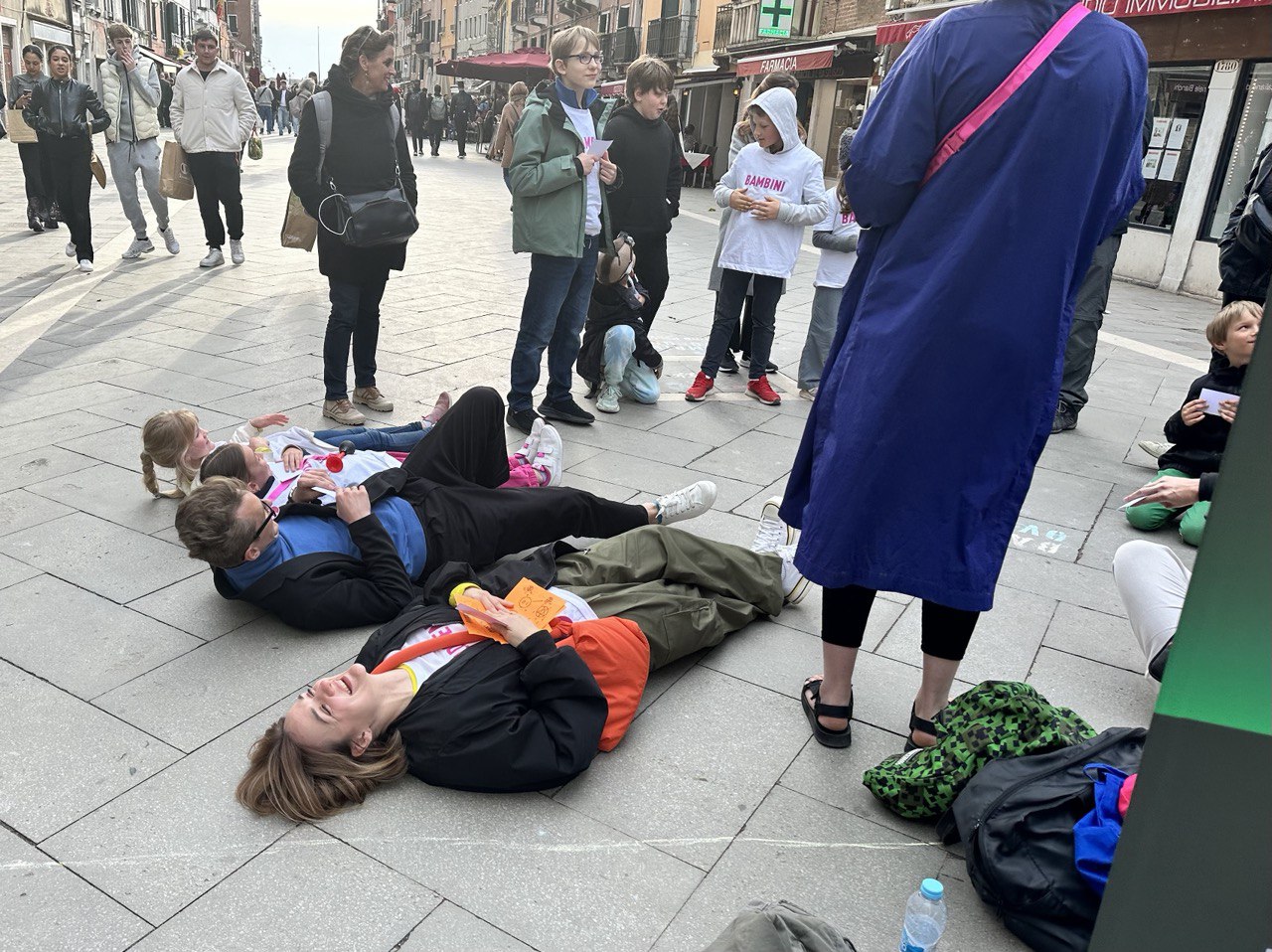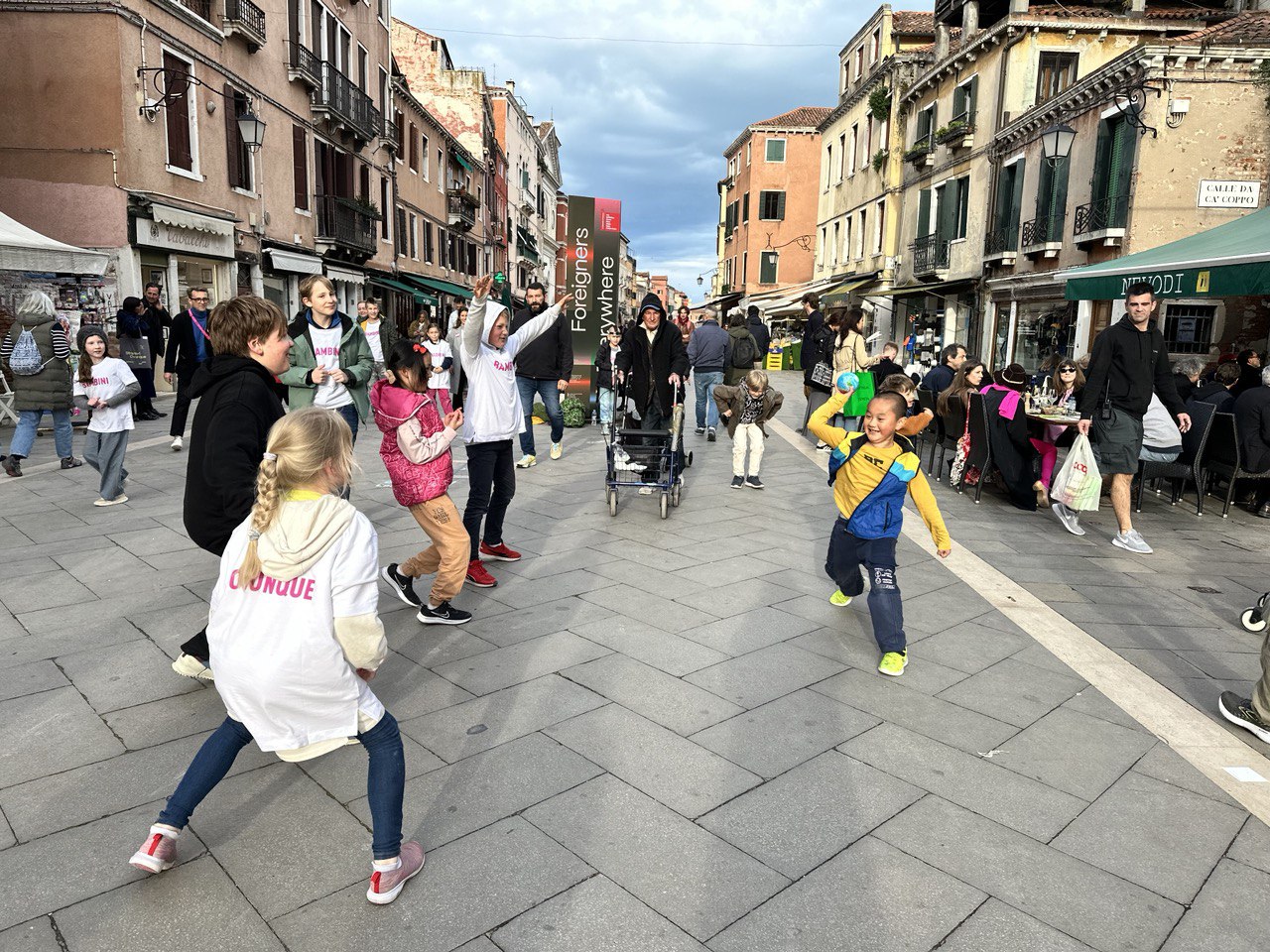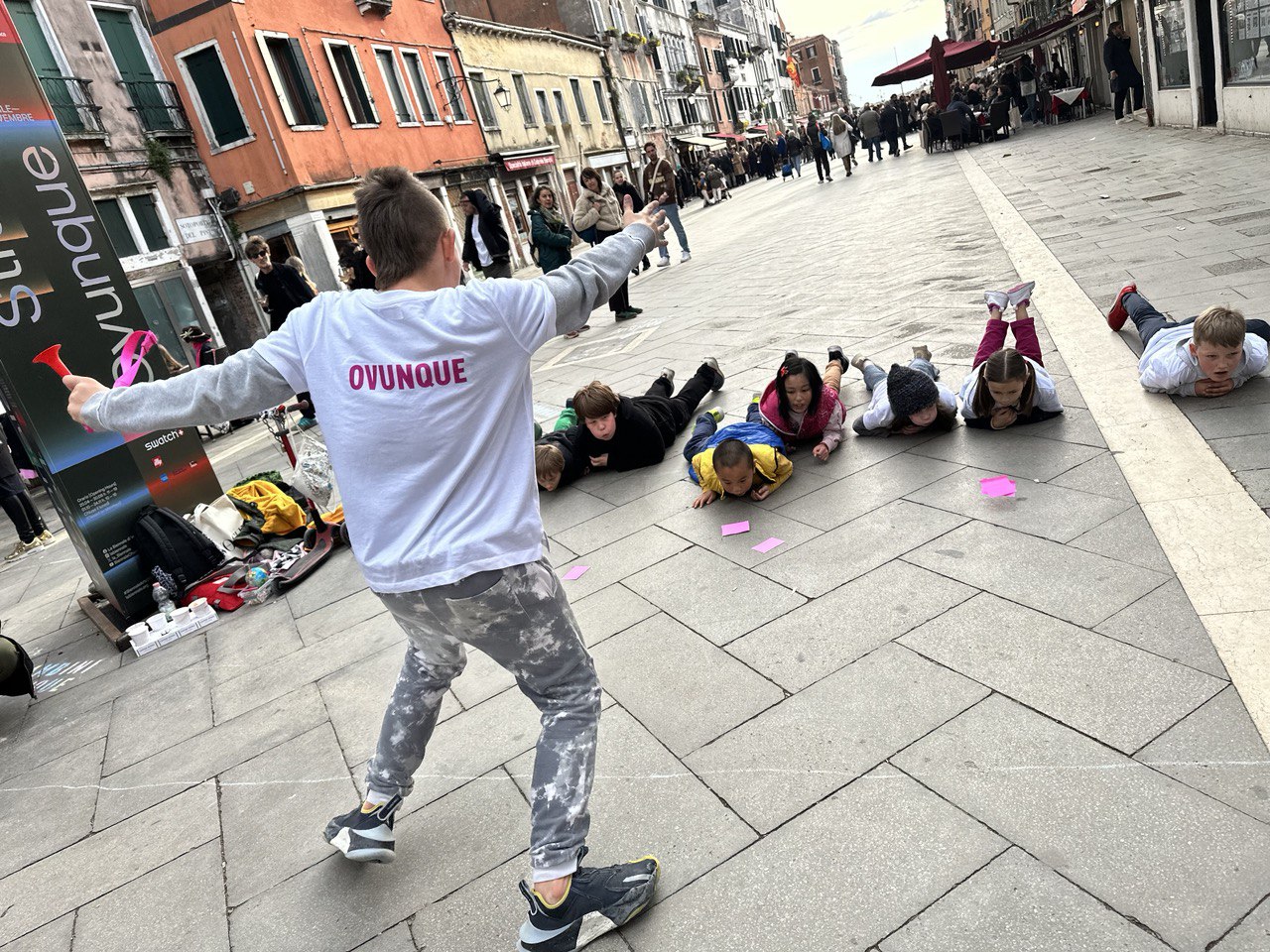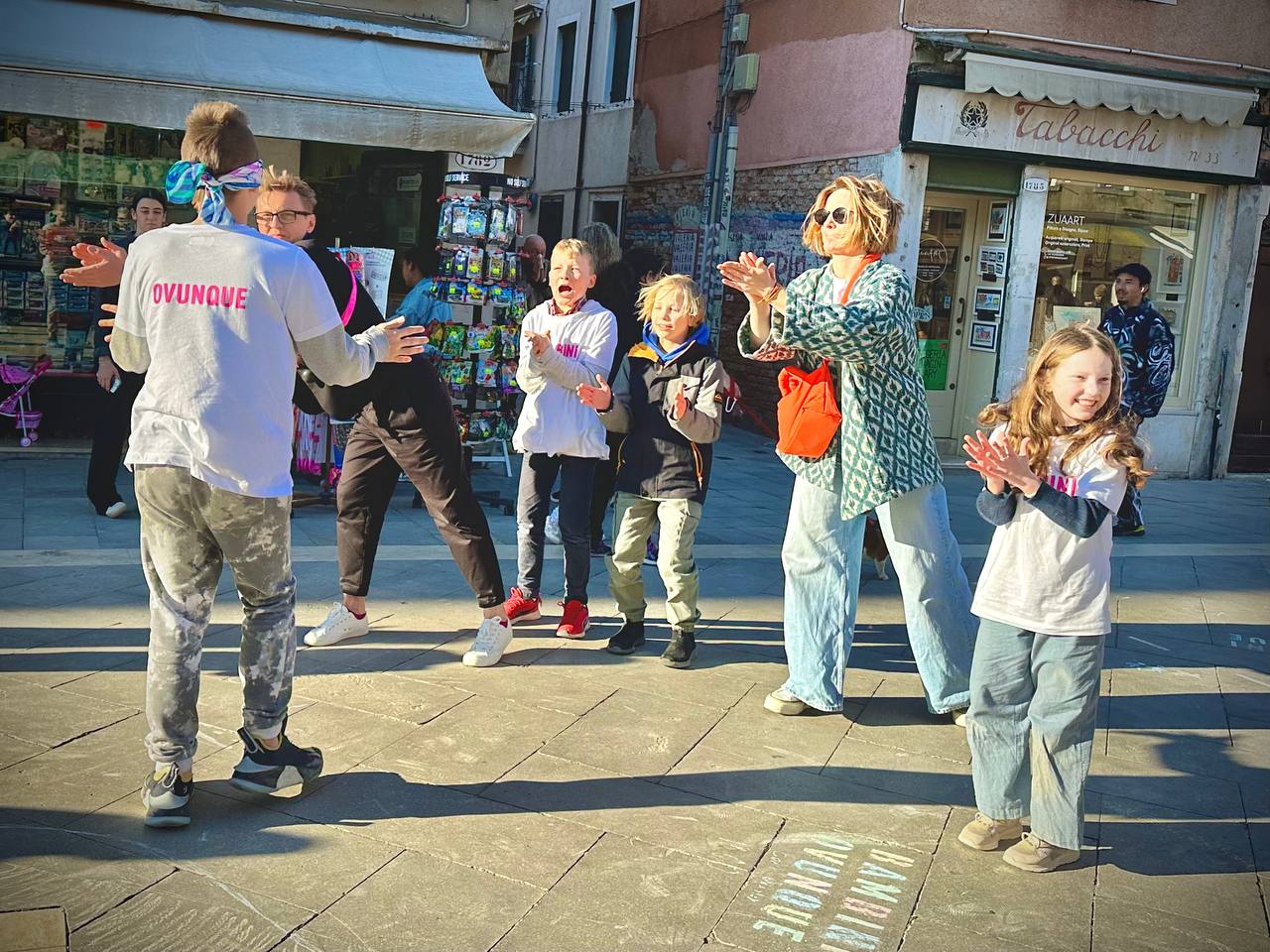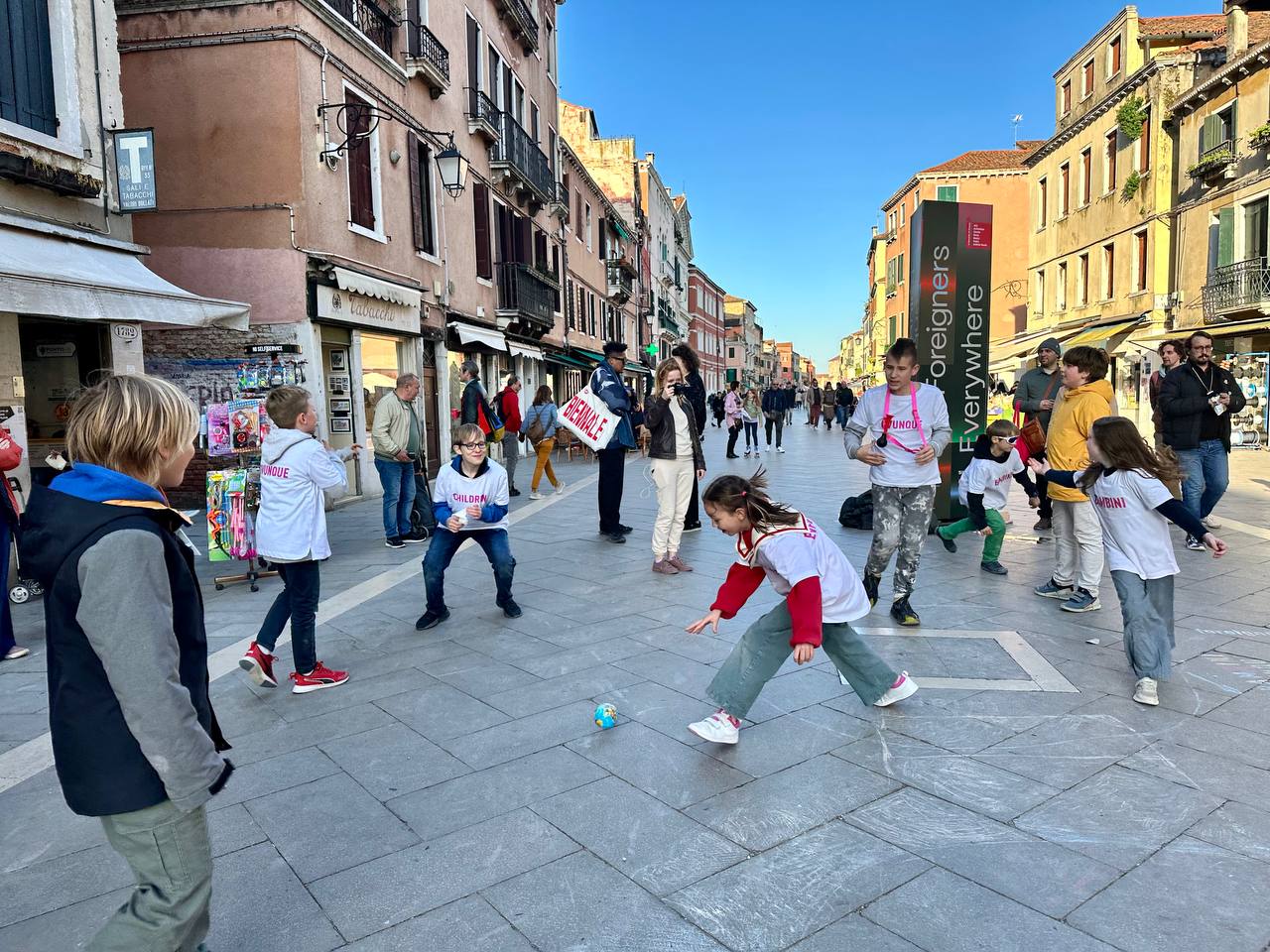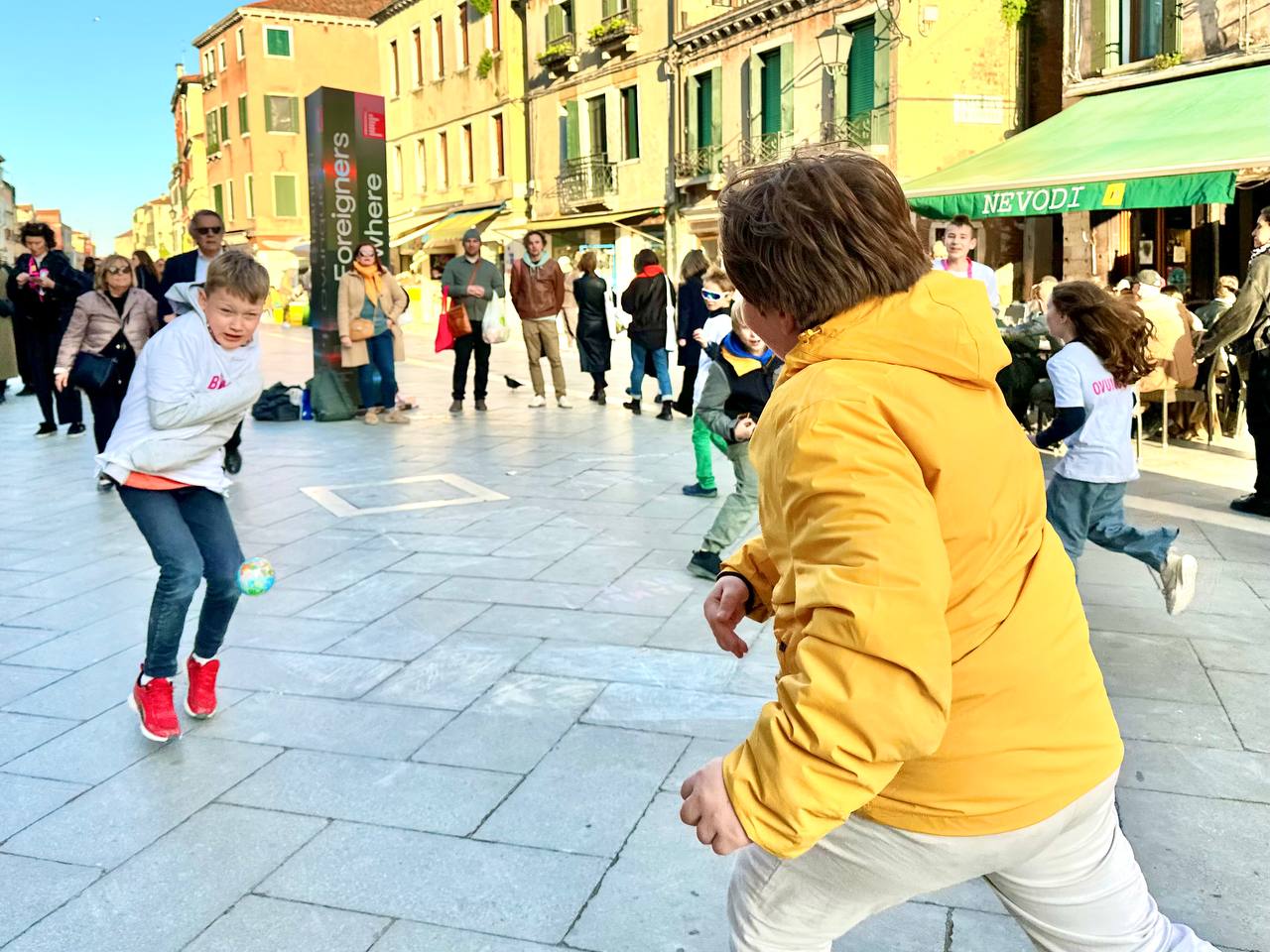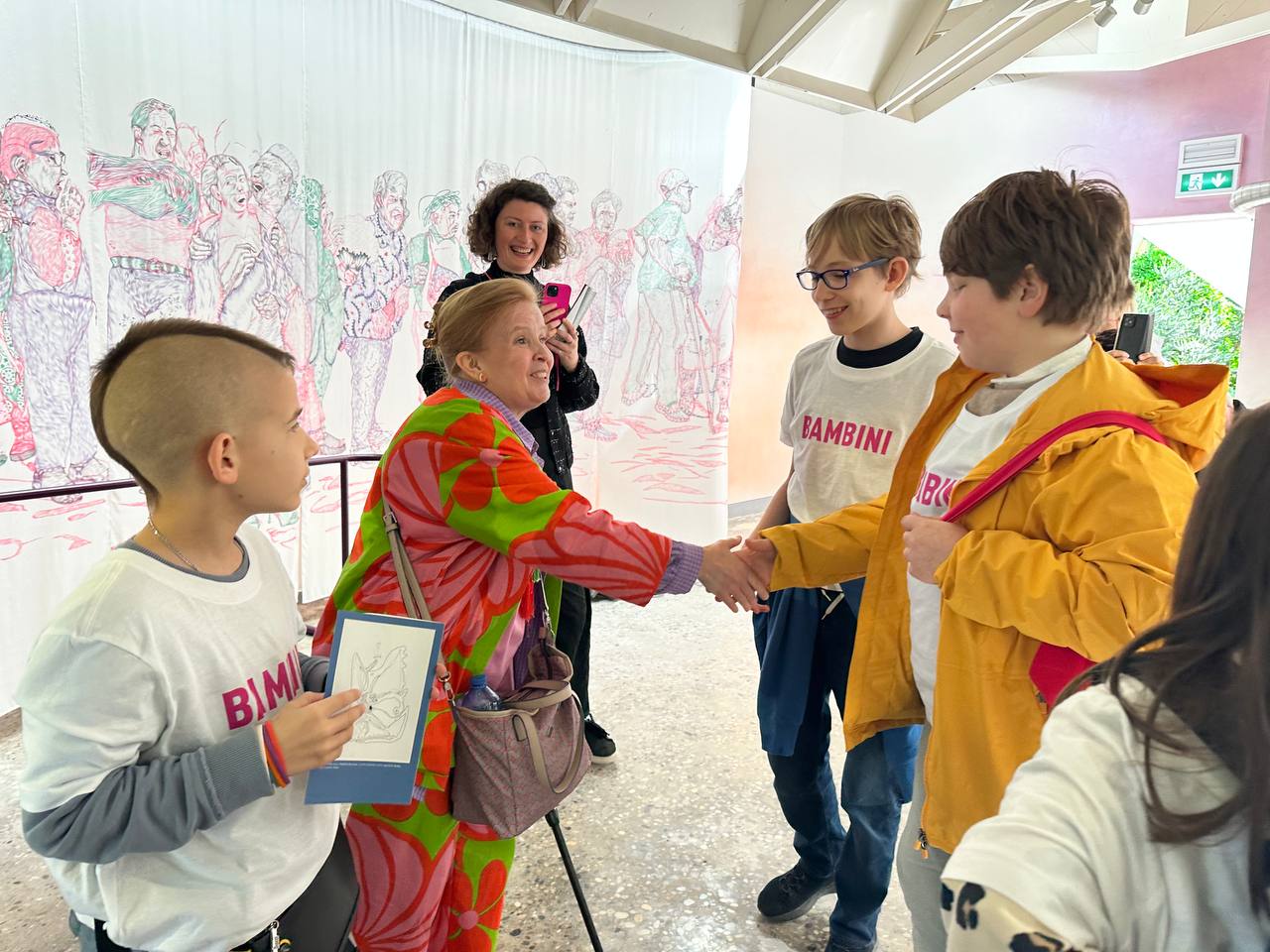Regaining a sense of belonging
Children Everywhere
A series of happenings in Venice to reconnect with the city through the tool of play
A project on the edge of art/urbanism/research conducted by children 8-13 y.o. and an interdisciplinary team of professionals. How to explore a city through the language of play and reconnect with the environment through games? How to explore the concept of childhood foreignness in the cities through games? Realized in Venice during the Venice Art Biennial 2024, unofficially, in the form of street games with ransom passersby, it showed how city spaces losing their sense of belonging to children.
Italy
National
Mainly urban
It refers to other types of transformations (soft investment)
Yes
2024-05-30
Yes
Creative Europe
No
No
As a representative of an organisation
The Children Everywhere project embodies the core values of the NEB by integrating sustainability, inclusion, and aesthetics into its design and implementation, offering both immediate and long-term benefits to communities.
Overall aims:
- Present play as a tool of relations and a way of discovering the city.
Target groups:
- Children 6+
- Families (migrants as authors of the project and locals)
- Artists and curators
Specific objectives:
- Present the city as an accessible space for all.
- Break down the barriers between children of different backgrounds, nationalities, and languages.
- Give participants a sense of safety in the public spaces of the city.
Achieved outcomes:
- 15 project creator children went through an educational program to prepare the project.
- 24 parents participated in the project (parents of the creator children).
- Over the course of three days in May, the project was implemented on the main streets of Venice: Garibaldi and surrounding areas, with 4-hour sessions each day.
- More than 200 people joined the project during the games.
- The recognition of the organizers, the Architectural Thinking School, increased as a place working with migrant children.
- Trust in the Architectural Thinking School grew among migrants, locals, and the professional community, both in Venice and Lisbon.
We integrate and promote NEB values:
- Sustainability: The project promotes sustainable living by teaching children and families about urban environments and local culture.
- Inclusion: Children Everywhere fosters inclusion by involving children, families and people of any age, from diverse backgrounds in the creative process.
- Participatory process and multi-level engagement: we use a participatory model, involving children, parents, professionals, and local stakeholders in the creation of the project.
- Transdisciplinary approach: we're combining expertise from urbanism, design, philosophy, game creation etc.
Overall aims:
- Present play as a tool of relations and a way of discovering the city.
Target groups:
- Children 6+
- Families (migrants as authors of the project and locals)
- Artists and curators
Specific objectives:
- Present the city as an accessible space for all.
- Break down the barriers between children of different backgrounds, nationalities, and languages.
- Give participants a sense of safety in the public spaces of the city.
Achieved outcomes:
- 15 project creator children went through an educational program to prepare the project.
- 24 parents participated in the project (parents of the creator children).
- Over the course of three days in May, the project was implemented on the main streets of Venice: Garibaldi and surrounding areas, with 4-hour sessions each day.
- More than 200 people joined the project during the games.
- The recognition of the organizers, the Architectural Thinking School, increased as a place working with migrant children.
- Trust in the Architectural Thinking School grew among migrants, locals, and the professional community, both in Venice and Lisbon.
We integrate and promote NEB values:
- Sustainability: The project promotes sustainable living by teaching children and families about urban environments and local culture.
- Inclusion: Children Everywhere fosters inclusion by involving children, families and people of any age, from diverse backgrounds in the creative process.
- Participatory process and multi-level engagement: we use a participatory model, involving children, parents, professionals, and local stakeholders in the creation of the project.
- Transdisciplinary approach: we're combining expertise from urbanism, design, philosophy, game creation etc.
Urban play
Participatory
Interdisciplinarity
Equality
Inter-generation
1. Sustainability: for realization of the project there's no need of special materials, constructions, tools etc. We're going "back to roots" using the pure language of communication, explaininig participants the rules of the games. We use only basic things which all families could have: balls, some stones from the street, rope, chalk to draw on the floor.
2. Environmentally conscious: urban interventions with games are done by reclaiming public spaces for children's activities. By promoting low-impact, reusable, and participatory design elements, we ensure that our work doesn't generate waste but rather revitalizes existing spaces.
3. Community engagement as a sustainable model: the project fosters long-term urban resilience by engaging children, families, and local stakeholders in the co-creation process, ensuring sustainable social structures.
4. Long-term live and impact: all the games that we specifically invented and developed for the project with children and a team of specialists can be easily recreated by other participants. Just like in childhood, games were passed down by word of mouth, so after our project, all the involved children could continue playing them on their own.
5. Scaling and continuation: the specifics of this project allow to repeat it constantly in different cities, contexts, with different children, families so practically project is realised but it could be done again and again, developing and finding new meanings. This year, 2025, we made a new project based on Children Everywhere, and were invited to participate to Venice Architectural Bienial in official program in May.
2. Environmentally conscious: urban interventions with games are done by reclaiming public spaces for children's activities. By promoting low-impact, reusable, and participatory design elements, we ensure that our work doesn't generate waste but rather revitalizes existing spaces.
3. Community engagement as a sustainable model: the project fosters long-term urban resilience by engaging children, families, and local stakeholders in the co-creation process, ensuring sustainable social structures.
4. Long-term live and impact: all the games that we specifically invented and developed for the project with children and a team of specialists can be easily recreated by other participants. Just like in childhood, games were passed down by word of mouth, so after our project, all the involved children could continue playing them on their own.
5. Scaling and continuation: the specifics of this project allow to repeat it constantly in different cities, contexts, with different children, families so practically project is realised but it could be done again and again, developing and finding new meanings. This year, 2025, we made a new project based on Children Everywhere, and were invited to participate to Venice Architectural Bienial in official program in May.
The Children Everywhere project serves as an exemplary model of how play/games and cultural participation can shape the aesthetics of urban life.
1. Street games are passed down orally and played collectively, reviving the tradition of games as intangible cultural heritage in contemporary urban settings.
2. By playing games, we help children (especially migrants) form a deeper connection with the urban environment.
3. Reimagining public space through playful design:the project revitalizes urban areas by turning streets, plazas, and hidden corners of Venice into sites of creative interaction.
1. Street games are passed down orally and played collectively, reviving the tradition of games as intangible cultural heritage in contemporary urban settings.
2. By playing games, we help children (especially migrants) form a deeper connection with the urban environment.
3. Reimagining public space through playful design:the project revitalizes urban areas by turning streets, plazas, and hidden corners of Venice into sites of creative interaction.
1. Accessibility and affordability for all: the project takes place in public spaces, ensuring that participation is free and open to all. Games require no expensive materials or complex structures, making them easy to replicate across different communities.
2. The games encourage multilingual participation, allowing children to overcome language barriers through play. To explain games we've printed visual materials -- infographics made by children-participants of the project, so everyone could understand the rules of the game, there's even no need to know English.
3. Intergenerational and social interaction: parents, families, artists and local residents are invited to engage with the games, strengthening community ties across generations.
4. Addressing spatial segregation and isolation: the project reclaims underused public spaces for collective play, transforming them into inclusive and welcoming environments. In last 60 years all these spaces in Venice, previously used by hundreds of children, are now empty, filled with tourists. We include children, families and just everyone in the life of the city through the games.
2. A sense of belonging: by attracting children with street games we provoke a dialogue with the city, so children don't feel strangers, foreigners in the city.
3. Inclusion of сhildren in a зrofessional event:
We specifically designed this project to take place during the Venice Art Biennale, believing that it is essential to include children in major cultural events. Instead of simply organizing standard workshop programs—commonly found at such events—we aimed to create something experimental and open to the wider public with the children. Also, together, we visited the Biennale multiple times, allowing the children to understand the core idea of the event, to feel themselves as a part of it.
2. The games encourage multilingual participation, allowing children to overcome language barriers through play. To explain games we've printed visual materials -- infographics made by children-participants of the project, so everyone could understand the rules of the game, there's even no need to know English.
3. Intergenerational and social interaction: parents, families, artists and local residents are invited to engage with the games, strengthening community ties across generations.
4. Addressing spatial segregation and isolation: the project reclaims underused public spaces for collective play, transforming them into inclusive and welcoming environments. In last 60 years all these spaces in Venice, previously used by hundreds of children, are now empty, filled with tourists. We include children, families and just everyone in the life of the city through the games.
2. A sense of belonging: by attracting children with street games we provoke a dialogue with the city, so children don't feel strangers, foreigners in the city.
3. Inclusion of сhildren in a зrofessional event:
We specifically designed this project to take place during the Venice Art Biennale, believing that it is essential to include children in major cultural events. Instead of simply organizing standard workshop programs—commonly found at such events—we aimed to create something experimental and open to the wider public with the children. Also, together, we visited the Biennale multiple times, allowing the children to understand the core idea of the event, to feel themselves as a part of it.
1. Children and Families:
The central focus of the project was the children (ages 8-13), particularly migrants, who were directly involved in the creation of games and activities. They worked with the Architectural Thinking School team, engaging in design workshops and creative sessions to reimagine public spaces through play. Their role was co-creational, meaning they had a direct hand in shaping the activities and urban interventions. Families were also included, joining the children during guided tours and community-based activities.
All this created a sense of ownership and empowerment, allowing them to see their ideas reflected in the space and recognize their contributions to the wider community.
2. Local residents:
Local residents were involved in the broader community-building aspect of Children Everywhere.
They also assisted with local outreach, helping the project to engage with residents who were not initially involved. Especially the older generation, who have lived in Venice their entire lives, were deeply moved by the project: they reminisced about how, in their youth, the streets were filled with children, life, and activity. They shared their memories with us and embraced our project with genuine joy.
3. Professional community, curators, artists:
Since the project took place during the opening of the Venice Biennale of Arts, both artists and curators joined in the games. They were intrigued by the project from a conceptual perspective. For us as organizers, this provided an opportunity to establish new professional connections. It's important for us as we plan to make similar projects in different contexts in the future.
The central focus of the project was the children (ages 8-13), particularly migrants, who were directly involved in the creation of games and activities. They worked with the Architectural Thinking School team, engaging in design workshops and creative sessions to reimagine public spaces through play. Their role was co-creational, meaning they had a direct hand in shaping the activities and urban interventions. Families were also included, joining the children during guided tours and community-based activities.
All this created a sense of ownership and empowerment, allowing them to see their ideas reflected in the space and recognize their contributions to the wider community.
2. Local residents:
Local residents were involved in the broader community-building aspect of Children Everywhere.
They also assisted with local outreach, helping the project to engage with residents who were not initially involved. Especially the older generation, who have lived in Venice their entire lives, were deeply moved by the project: they reminisced about how, in their youth, the streets were filled with children, life, and activity. They shared their memories with us and embraced our project with genuine joy.
3. Professional community, curators, artists:
Since the project took place during the opening of the Venice Biennale of Arts, both artists and curators joined in the games. They were intrigued by the project from a conceptual perspective. For us as organizers, this provided an opportunity to establish new professional connections. It's important for us as we plan to make similar projects in different contexts in the future.
Children Everywhere is a project bringing together immigrants, children from Ukraine, Latvia, Belarus, Russia, whose families left their countries because of the war in Ukraine and political repressions, who are now scattered around the world waiting for residence permits and don’t know what their final destination will be next year. All our participants, group of the children 8-13 y.o., currently living in Portugal. And Architectural Thinking School, an organizer of the project, is based in Lisbon, Portugal. There we worked in partnership with a huge cultural center CCB (https://www.ccb.pt/en/evento/architectural-thinking-school-for-children/) which supported us providing space and tools to prepare the project. For CCB, it was important to support our project during its development stage, as the organization focuses on immigrant integration, community diversity, and unique, innovative programs.
The participants—students and their families—visited Venice for the first time, attending one of the most important cultural events. They gained insights into Venice, its history, and architectural values. We organized special tours for the project participants at the Biennale to introduce them to the world of art and showcase the pavilions of different countries. We held two 5-hour tours, analyzing the pavilions and curatorial concepts together with the children.
For us, organizers, it was very important to show that international community of children could be participants of such high-level events. We found new contacts, potential partnerships, and as a result were chosen to participate with different project in the next Venice architecture Bienial officially.
The participants—students and their families—visited Venice for the first time, attending one of the most important cultural events. They gained insights into Venice, its history, and architectural values. We organized special tours for the project participants at the Biennale to introduce them to the world of art and showcase the pavilions of different countries. We held two 5-hour tours, analyzing the pavilions and curatorial concepts together with the children.
For us, organizers, it was very important to show that international community of children could be participants of such high-level events. We found new contacts, potential partnerships, and as a result were chosen to participate with different project in the next Venice architecture Bienial officially.
For the development of the games we played in Venice, we conducted an educational block of 12 sessions for the participants/creators of the project, each lasting 3 hours, in Lisbon. During these sessions, we covered the following disciplines:
- Urbanism: We explored the basics of urbanism with the child creators of the project, studying how a city is organized. Specifically, we focused on Venice, its features, and how to design suitable games for the city's public spaces.
- Infographics: We studied how graphical images can convey information without using text, in order to communicate game-related information to as many people as possible through printed infographics.
- Philosophy: Together with the participants, we explored the phenomenon of play in philosophy and discussed its significance as an essential part of human life.
- Game Design: We examined the structure of various types of games, from video games to board games, how game elements manifest in education (edutainment), and the main components of a game. This knowledge allowed us to create our own well-designed street games.
- Games as Intangible Culture: We researched street games from different times, countries, and cultures to understand how they are connected to culture and context, and how they convey deep meanings.
- Contemporary Art: Since the project took place during the Venice Biennale of Arts, part of the sessions were dedicated to understanding contemporary art. We explored concepts like performance art and happenings, as Children Everywhere can be categorized within these areas.
- Urbanism: We explored the basics of urbanism with the child creators of the project, studying how a city is organized. Specifically, we focused on Venice, its features, and how to design suitable games for the city's public spaces.
- Infographics: We studied how graphical images can convey information without using text, in order to communicate game-related information to as many people as possible through printed infographics.
- Philosophy: Together with the participants, we explored the phenomenon of play in philosophy and discussed its significance as an essential part of human life.
- Game Design: We examined the structure of various types of games, from video games to board games, how game elements manifest in education (edutainment), and the main components of a game. This knowledge allowed us to create our own well-designed street games.
- Games as Intangible Culture: We researched street games from different times, countries, and cultures to understand how they are connected to culture and context, and how they convey deep meanings.
- Contemporary Art: Since the project took place during the Venice Biennale of Arts, part of the sessions were dedicated to understanding contemporary art. We explored concepts like performance art and happenings, as Children Everywhere can be categorized within these areas.
1. A new perspective on children's participation in events. Usually, a separate program is created for children, which is only attended by families and children and exists outside the main programs of professional events. We believe that a child can very well be part of a serious event, thereby emphasizing the importance of the child and their voice in society.
2. Think-tank with professionals. Children, together with professionals (architects, artists, designers), came up with the project. Usually, children work with educators, but not with practitioners in their respective fields. In this project, children worked with practitioners and international-level experts.
3. Working with migrant community. The project was developed together with migrants currently in vulnerable situations. We work with migrants from Eastern European countries: Ukraine, Lithuania, Belarus, Russia. During the project, we used education as soft power to create a friendly, peaceful community where respect and mutual understanding were the basis for communication.
4. Living Lab and Site-Specific approach. We didn't create special pavilions or artificial environments, but instead used what was already there: the urban space. Our initial research was conducted remotely, while we were in Lisbon, using Google Maps and trying to virtually explore the city.
5. Children's involvement at all levels. Even for distributing information about the project, participants, children aged 8-13, were involved. We walked around Venice together, made stencils with the project's name (in Italian, Bambini Ovunque), handed out leaflets with game maps to local children, and invited them to play with us. Our students felt like serious organizers of a real project.
2. Think-tank with professionals. Children, together with professionals (architects, artists, designers), came up with the project. Usually, children work with educators, but not with practitioners in their respective fields. In this project, children worked with practitioners and international-level experts.
3. Working with migrant community. The project was developed together with migrants currently in vulnerable situations. We work with migrants from Eastern European countries: Ukraine, Lithuania, Belarus, Russia. During the project, we used education as soft power to create a friendly, peaceful community where respect and mutual understanding were the basis for communication.
4. Living Lab and Site-Specific approach. We didn't create special pavilions or artificial environments, but instead used what was already there: the urban space. Our initial research was conducted remotely, while we were in Lisbon, using Google Maps and trying to virtually explore the city.
5. Children's involvement at all levels. Even for distributing information about the project, participants, children aged 8-13, were involved. We walked around Venice together, made stencils with the project's name (in Italian, Bambini Ovunque), handed out leaflets with game maps to local children, and invited them to play with us. Our students felt like serious organizers of a real project.
All our work was like in a real think-tank.
1. Research with children: How, together with children and teenagers, we can respond to the theme of the 2024 Biennale Foreigners Everywhere, taking into account the specifics of the Architectural Thinking School, our focus on architecture and urbanism. We organized a brainstorming session with the school team, parents, and children. Together with the entire Architectural Thinking School for Children community, through discussions and voting, we decided to implement the Children Everywhere project.
2. Project development with an emphasis on educational role: To create a project for the Venice Biennale with children, we first needed to immerse the children and teenagers in the essence of the Biennale—what it is, how it is organized, and how projects can be implemented. From November 2023 to April 2024, we carried out an educational program related to the Children Everywhere project. Each lesson was divided into theory, practice, and idea presentations. For example, in the session on the history of street games, each child chose a country, researched it on the internet, tried to record the rules of the game they found using infographics (without words), and at the end of the session, each presented their game, after which we all tried playing it and discussed how feasible and appropriate it would be to play it in Venice.
3. Creating their own games: Based on the knowledge gained in the educational program, each student was tasked with developing their own outdoor street game, writing simple rules for it, and creating an infographic for it.
4. Project testing: we invited anyone from the school community, parents of the children, and tried playing the games in Lisbon. The test lasted for 4 hours. After that, we organized a picnic to discuss: what worked, what should be adjusted, etc.
5. Engagement: The implementation of the project involved both the school team (5 people) and the parents of the children.
1. Research with children: How, together with children and teenagers, we can respond to the theme of the 2024 Biennale Foreigners Everywhere, taking into account the specifics of the Architectural Thinking School, our focus on architecture and urbanism. We organized a brainstorming session with the school team, parents, and children. Together with the entire Architectural Thinking School for Children community, through discussions and voting, we decided to implement the Children Everywhere project.
2. Project development with an emphasis on educational role: To create a project for the Venice Biennale with children, we first needed to immerse the children and teenagers in the essence of the Biennale—what it is, how it is organized, and how projects can be implemented. From November 2023 to April 2024, we carried out an educational program related to the Children Everywhere project. Each lesson was divided into theory, practice, and idea presentations. For example, in the session on the history of street games, each child chose a country, researched it on the internet, tried to record the rules of the game they found using infographics (without words), and at the end of the session, each presented their game, after which we all tried playing it and discussed how feasible and appropriate it would be to play it in Venice.
3. Creating their own games: Based on the knowledge gained in the educational program, each student was tasked with developing their own outdoor street game, writing simple rules for it, and creating an infographic for it.
4. Project testing: we invited anyone from the school community, parents of the children, and tried playing the games in Lisbon. The test lasted for 4 hours. After that, we organized a picnic to discuss: what worked, what should be adjusted, etc.
5. Engagement: The implementation of the project involved both the school team (5 people) and the parents of the children.
All core elements of the project are easy to replicate in different contexts:
1. Methodology of co-creation with children:
The process of engaging children as co-creators of the project is central to the methodology of Children Everywhere. This model can be replicated in various communities, integrating children into the planning and execution of creative projects in diverse contexts, such as festivals, public spaces, or educational institutions.
2. Educational program framework: The structured educational program, which incorporates a blend of theory, practice, and creative workshops. The program is written and saved in documents, with instructions for tutors, suggestions and tools to help to realize it.
3. Game design and play as cultural tools: The concept of developing simple yet meaningful games using local cultural references can be easily replicated in different cities, especially those with diverse histories and cultural practices. Also it could be done not only with children but with and for adults.
4. Living Lab and site-specific approach: the space of the city itself is the "stage" for the games, so the project can be easily adapted to any city. The approach encourages children to interact with their urban environment and develop games that respond to its unique features.
5. Community involvement and engagement: The model of engaging not only children but also families and local communities (through activities like chalk drawing, flyers, and participatory events) can be replicated. So the project could be used to achieve various goals: to strengthen the bounds of community feeling, as an ice-breaker, as regular activity in schools etc.
6. Social Integration of Migrants: The project could be used as a tool for work with vulnerable migrant communities, fostering understanding, integration, and mutual respect through the language of game.
1. Methodology of co-creation with children:
The process of engaging children as co-creators of the project is central to the methodology of Children Everywhere. This model can be replicated in various communities, integrating children into the planning and execution of creative projects in diverse contexts, such as festivals, public spaces, or educational institutions.
2. Educational program framework: The structured educational program, which incorporates a blend of theory, practice, and creative workshops. The program is written and saved in documents, with instructions for tutors, suggestions and tools to help to realize it.
3. Game design and play as cultural tools: The concept of developing simple yet meaningful games using local cultural references can be easily replicated in different cities, especially those with diverse histories and cultural practices. Also it could be done not only with children but with and for adults.
4. Living Lab and site-specific approach: the space of the city itself is the "stage" for the games, so the project can be easily adapted to any city. The approach encourages children to interact with their urban environment and develop games that respond to its unique features.
5. Community involvement and engagement: The model of engaging not only children but also families and local communities (through activities like chalk drawing, flyers, and participatory events) can be replicated. So the project could be used to achieve various goals: to strengthen the bounds of community feeling, as an ice-breaker, as regular activity in schools etc.
6. Social Integration of Migrants: The project could be used as a tool for work with vulnerable migrant communities, fostering understanding, integration, and mutual respect through the language of game.
1. Social integration and inclusion of migrants: Children Everywhere specifically engages with migrant communities, many of whom are in vulnerable positions. In the context of a global migration crisis, the project helps integrate children and their families into new communities, fostering mutual understanding and respect.
2. Access to quality and experimental education and learning opportunities: The project addresses the global challenge of equitable access to quality education by providing children from different backgrounds (including migrants, disadvantaged communities, and refugees) with an opportunity for experiential, interdisciplinary learning.
3. Cultural preservation and awareness: By involving children in creating games based on their cultural heritage and local history, project addresses the challenge of cultural preservation and the risk of cultural homogenization in a globalized world.
4. Urbanization and public space accessibility: With rapid urbanization and increasing challenges related to public space accessibility, project promotes a more inclusive and participatory approach to urban planning. By encouraging children to engage with environment and design games that respond to the specific characteristics of their city (in this case, Venice), the project emphasizes the importance of creating public spaces that are accessible, enjoyable, and meaningful for everyone, including children and marginalized groups.
5. Youth empowerment and active citizenship: The project empowers children by involving them as active participants in a professional event like the Venice Biennale.
6. Mental health and wellbeing: In a world increasingly focused on digital technologies and often disconnected from physical play and outdoor activities, Children Everywhere promotes the importance of play as a key element of mental and physical wellbeing. The project encourages children to engage in active play, social interaction, and collaborative work.
2. Access to quality and experimental education and learning opportunities: The project addresses the global challenge of equitable access to quality education by providing children from different backgrounds (including migrants, disadvantaged communities, and refugees) with an opportunity for experiential, interdisciplinary learning.
3. Cultural preservation and awareness: By involving children in creating games based on their cultural heritage and local history, project addresses the challenge of cultural preservation and the risk of cultural homogenization in a globalized world.
4. Urbanization and public space accessibility: With rapid urbanization and increasing challenges related to public space accessibility, project promotes a more inclusive and participatory approach to urban planning. By encouraging children to engage with environment and design games that respond to the specific characteristics of their city (in this case, Venice), the project emphasizes the importance of creating public spaces that are accessible, enjoyable, and meaningful for everyone, including children and marginalized groups.
5. Youth empowerment and active citizenship: The project empowers children by involving them as active participants in a professional event like the Venice Biennale.
6. Mental health and wellbeing: In a world increasingly focused on digital technologies and often disconnected from physical play and outdoor activities, Children Everywhere promotes the importance of play as a key element of mental and physical wellbeing. The project encourages children to engage in active play, social interaction, and collaborative work.
1. Empowerment local children and families
By involving them in active games, the project facilitated integration into urban environment. Participants felt a renewed sense of connection to the city of Venice, not just as visitors but as active contributors to the cultural landscape.
2. Celebrating cultural diversity and tradition through play.
Children learned about different cultural traditions through the medium of play. This fostered cultural understanding and mutual respect. The project contributed to a broader cultural dialogue, as children learned how their own cultural backgrounds can be interwoven with the cultural fabric of the city.
3. Strengthening social cohesion and fostering community bonds.
The collaborative process of designing games based on historical and contemporary aspects of the city allowed for dialogue across different generations, backgrounds, and experiences.
Children and adults worked side-by-side, exploring urban spaces together, exchanging memories, and learning from each other’s experiences. This created new social ties and reinforced community bonds.
4. Enhancing the sense of belonging to the city of Venice. The project encouraged an appreciation for Venice’s rich history and contemporary dynamics, helping children to understand their place in the city and its ongoing narrative.
5. Regenerating and repurposing public space for children.
By utilizing the existing public spaces of Venice, the Children Everywhere project repurposed urban environments into interactive play zones. This approach did not rely on constructing new spaces but rather transformed the existing environment into a space for connection, play, and learning.
6. Importance of education for migrant community.
Thus, more migrant children joined other programs and projects in the Architectural Thinking School. Parents recognized the importance of the Children Everywhere project and wanted to become more involved in similar initiatives.
By involving them in active games, the project facilitated integration into urban environment. Participants felt a renewed sense of connection to the city of Venice, not just as visitors but as active contributors to the cultural landscape.
2. Celebrating cultural diversity and tradition through play.
Children learned about different cultural traditions through the medium of play. This fostered cultural understanding and mutual respect. The project contributed to a broader cultural dialogue, as children learned how their own cultural backgrounds can be interwoven with the cultural fabric of the city.
3. Strengthening social cohesion and fostering community bonds.
The collaborative process of designing games based on historical and contemporary aspects of the city allowed for dialogue across different generations, backgrounds, and experiences.
Children and adults worked side-by-side, exploring urban spaces together, exchanging memories, and learning from each other’s experiences. This created new social ties and reinforced community bonds.
4. Enhancing the sense of belonging to the city of Venice. The project encouraged an appreciation for Venice’s rich history and contemporary dynamics, helping children to understand their place in the city and its ongoing narrative.
5. Regenerating and repurposing public space for children.
By utilizing the existing public spaces of Venice, the Children Everywhere project repurposed urban environments into interactive play zones. This approach did not rely on constructing new spaces but rather transformed the existing environment into a space for connection, play, and learning.
6. Importance of education for migrant community.
Thus, more migrant children joined other programs and projects in the Architectural Thinking School. Parents recognized the importance of the Children Everywhere project and wanted to become more involved in similar initiatives.

